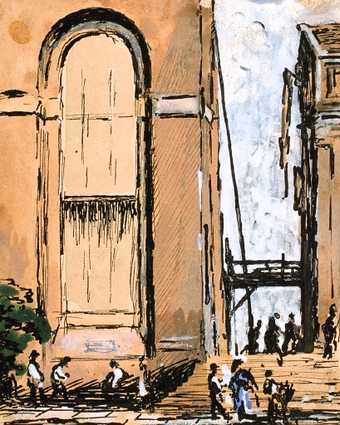This memorial exhibition of the work of James Pryde was another version of the one arranged by the Arts Council’s Scottish Office to honour him appropriately in the land of his birth.
Several interesting early works by Pryde were to be seen in this exhibition, among them the sensitive charcoal Portrait of Miss Burnet, done in Edinburgh about 1886, and the wash drawing Caprice No. 2, reminiscent of Beardsley and Conder, a typical product of the 1890s.
During the 1890s, Pryde several times played small parts on the stage, to make a little money: the stage powerfully affected his artistic imagination by its emphasis on light and shade, and by showing him how the human figure could be dwarfed by a tall proscenium arch. The great doors at the back of a stage may well have been in his mind when he painted such canvases as Lumber.
One of the earliest of Pryde’s architectural pictures was the Guildhall with Figures, exhibited in 1905 at the International Society of Sculptors, Painters and Gravers, and purchased by Sargent. The Doctor, the first of his bed pictures (later acquired for the Tate Gallery under the Chantrey Bequest), was exhibited in 1909 at the same Society, of which Pryde eventually became vice president.
In the last fifteen years of his life Pryde produced little. Perhaps his last important picture was The Grave acquired by the Tate Gallery in 1929.
Derek Hudson


